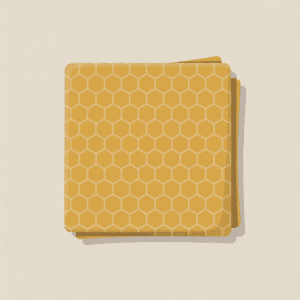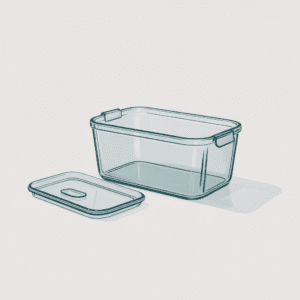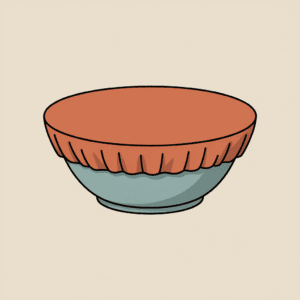You know that moment when plastic wrap sticks to itself instead of the bowl? Or when you finally get it stretched across your casserole dish, only to watch it slowly peel back from the edges? Peter Griffin from Family Guy certainly does:
We’ve all been there. And we’ve all wondered if there’s something better out there. Good news: there is.
Why Plastic Wrap Deserves Its Bad Reputation
Plastic wrap fails us in so many ways. It tears at the worst moments, creates static-filled tangles, and never quite seals the way we need it to.
But the problems run deeper than daily annoyances. Most plastic wraps contain chemicals that can transfer into food, especially when heated. Each sheet joins the 380 million tons of plastic produced annually, and recycling isn’t an option for most cling films. Every piece you’ve used still exists somewhere.
The strangest part? We keep buying it out of habit, even though better options surround us. Options that work better, last longer, and don’t make us curse under our breath while trying to cover leftover pasta.
5 Alternatives That Make Plastic Wrap Obsolete
1. Beeswax Wraps: The Natural Solution

Beeswax wraps feel different from the moment you pick them up. The cotton fabric, infused with beeswax, tree resin, and jojoba oil, has a subtle tackiness and a warm, honey-like scent.
Press one against a bowl’s rim, and your hand’s warmth makes it moldable. It grips without suffocating, creating a breathable seal that plastic wrap can only dream of achieving. Your cheese stays fresh without getting slimy. Your cut avocado doesn’t turn brown as quickly. Lettuce remains crisp instead of wilting in its own moisture.
Works best with: Cheese, fruits, vegetables, bowl covers, sandwiches Typical lifespan: 6-12 months with regular use Maintenance: Cool water, gentle soap, air dry
2. Silicone Stretch Lids: Flexible Coverage
![]()
Silicone stretch lids solve the universal kitchen puzzle of mismatched containers and lids. These flexible discs stretch to accommodate different sizes, creating genuine airtight seals.
Watch one in action and you’ll understand the appeal. The silicone grips the rim completely, no gaps or slowly loosening edges. They handle temperature extremes without complaint—from freezer storage to microwave reheating. And unlike plastic wrap’s one-time use, these bounce back to their original shape, ready for the next task.
Ideal for: Bowl coverage, open cans, cut produce like melon halves Durability: Several years of regular use Temperature tolerance: Freezer to microwave safe
3. Glass Containers: Simple and Effective

Sometimes eliminating a problem means eliminating the need for a solution. Glass containers with secure lids remove wrap from the equation entirely.
Pour soup directly from pot to container. Stack prepped ingredients for the week ahead. See contents without opening lids or peeling back layers. Glass won’t hold onto yesterday’s garlic smell or last week’s tomato sauce stains. The transparency eliminates mystery leftovers lurking in the back of the refrigerator.
Handles everything: Liquids, solids, meal prep, long-term storage Investment consideration: Higher initial cost, decades of use Shopping tip: Locking lids ensure maximum freshness
4. Silicone Food Bags: Modern Storage Reimagined
![]()
These substantial silicone bags share nothing with flimsy sandwich baggies except their basic shape. The thick material stands upright, seals completely, and transitions seamlessly from freezer to microwave.
Their transparency rivals glass, while their flexibility accommodates awkward shapes and sizes. Write directly on them with dry erase markers for dating leftovers or labeling marinades. They handle liquids without leaking, something plastic wrap never mastered despite decades of trying.
Perfect for: Marinades, liquid storage, portion freezing, sous vide Temperature flexibility: Safe from freezer to boiling water Value perspective: One bag replaces hundreds of disposable wraps
5. Cotton Bowl Covers: Practical Charm

Cotton bowl covers bring unexpected elegance to food storage. These fabric circles with elastic edges slip over bowls in seconds, no wrestling or readjusting required.
They excel during food preparation—covering rising dough, protecting salads before serving, or shielding outdoor dishes from insects. Machine washable fabric means they’re always ready for use, and the variety of patterns adds personality to practical storage.
Excellent for: Food prep coverage, transport protection, outdoor dining Design options: Endless patterns and colors available Care simplicity: Toss in the washing machine
Unexpected Rewards of Going Reusable
The benefits extend far beyond reducing waste. Your food actually stays fresher when it can breathe properly. Cheese maintains its texture, vegetables keep their crunch, and bread doesn’t develop that plastic wrap condensation that accelerates molding.
Financially, the math works in your favor immediately. A family typically spends over $100 annually on plastic wrap. Quality reusables cost about the same but last for years, not moments.
Daily kitchen tasks become smoother. No more rewrapping because the plastic tore. No more fighting with static-charged sheets. These alternatives cooperate instead of complicate.
Perhaps most satisfying is the absence of guilt. Each covered bowl or wrapped sandwich represents one less piece of plastic in the world. Small actions, multiplied daily, create meaningful change.
Starting Your Plastic-Free Journey
Transformation doesn’t require perfection. Select one alternative that matches your most common plastic wrap use. If you frequently cover bowls, try silicone lids. If you wrap cheese often, invest in beeswax wraps.
Use your chosen alternative exclusively for one week. Notice how it performs compared to plastic wrap. Most people discover their new method works better, encouraging them to expand their collection naturally.
Within a month, you’ll reach for reusables automatically. That plastic wrap roll becomes backup for rare occasions, then eventually leaves your kitchen entirely.
A Better Way Forward
Abandoning plastic wrap improves your kitchen experience while reducing environmental impact. These alternatives offer superior performance, not just eco-friendly substitutes.
Each time you effortlessly cover food without plastic wrap drama, you’ll appreciate the upgrade. Better function, less waste, more satisfaction—the combination makes switching inevitable once you experience the difference.
Your kitchen deserves tools that work reliably. Your food deserves storage that maintains freshness. And yes, the planet benefits when we choose reusables over disposables.
The only question remaining: which alternative will you test first?
This page contains affiliate links. As an Amazon Associate, we earn from qualifying purchases
We may also earn a commission from purchases made through other affiliate links at no extra cost to you.
